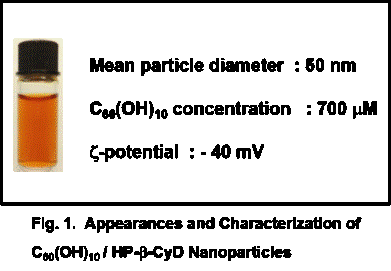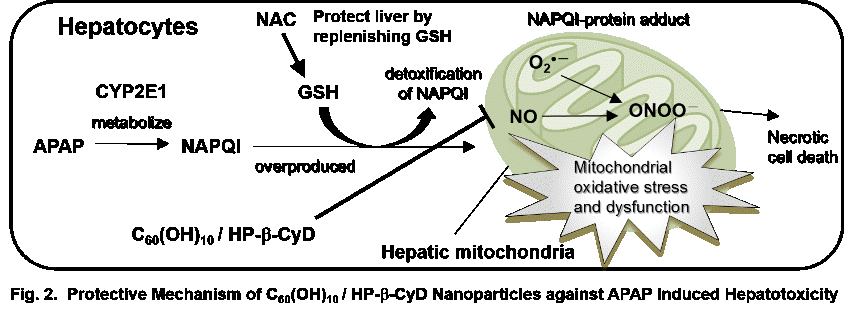Introduction: C60(OH)10 is a C60 derivative that 10 hydroxyl groups are introduced into a C60 molecule. It has been reported that polyhydroxylated C60 has a powerful antioxidant activity compared to unmodified C60. Although C60(OH)10 is more soluble than unmodified C60, further enhancement in its solubility is necessary for a precise evaluation of their biological activities and for extensive biomedical applications. In a previous study, we reported on the preparation of stable C60 nanoparticles (mean particle size ca. 90 nm), the surfaces of which were covered by hydrophilic 2-hydroxypropyl-β-cyclodextrin (HP-β-CyD) through physical adsorption and weak hydrophobic interaction. In this study, we prepared the stable hydrophilic C60(OH)10 nanoparticles using HP-β-CyD, and investigated the therapeutic effect of C60(OH)10 nanoparticles as an antioxidant on the acetaminophen (APAP) overdose-induced liver injury.
Materials and Method: C60(OH)10/HP-β-CyD nanoparticles were prepared by grinding the mixture of C60(OH)10 and HP-β-CyD (mainly 1:3 molar ratio) for 3h at 4ºC under reduced pressure. The resulting nanoparticles were characterized by means of a dynamic light scattering machine (DLS), a z-potential analyzer and TEM. The antioxidant ability of C60(OH)10/HP-β-CyD nanoparticles was evaluated by the scavenging ability against DPPH, ABTS and hydroxyl radicals. C60(OH)10/HP-β-CyD nanoparticles were applied to the treatment of an APAP overdose-induced liver injury. Serum ALT and AST levels were monitored in order to measure the level of the liver injury.
Results and Discussion: C60(OH)10/HP-β-CyD nanoparticles showed a small particle size, ca. 50 nm, and maintained this size over 28 days in water at 25˚C. C60(OH)10/HP-β-CyD nanoparticles scavenged DPPH, ABTS and hydroxyl radicals in a dose dependent manner. When C60(OH)10/HP-β-CyD nanoparticles were intravenously administered to mice with a liver injury induced by an overdose of APAP, the ALT and AST levels were markedly reduced to almost the same level as that of normal mice. These results clearly indicate that C60(OH)10/HP-β-CyD nanoparticles have a protective effect against the progression of the liver injury. To reveal the mechanism responsible for liver protection by C60(OH)10/HP-β-CyD nanoparticles, GSH level, CYP2E1 expression and peroxynitrite formation in the liver were assessed. C60(OH)10/HP-β-CyD nanoparticles had no effect on CYP2E1 expression and GSH depletion, but suppressed the generation of peroxynitrite in the liver.
Conclusion: The findings indicate that C60(OH)10/HP-β-CyD nanoparticles protect the liver by suppression of oxidative stress occurred in mitochondria, scavenging ROS such as O2•-, NO and peroxynitrite, which act as critical mediators in the liver injuries.


References:
[1] Iohara et al., Biomaterials, 45, 115-123 (2015).